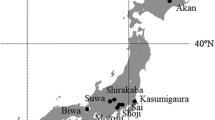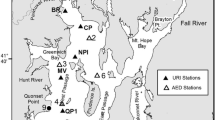Abstract
To evaluate measures and to analyze the possibilities of achieving lake restoration goals a model was developed to calculate Secchi depth and diffuse attenuation for PAR (Kpar). Inputs in the model are water the quality parameters chlorophyll-a, inorganic suspended matter, detritus and yellow substance. The model uses a spectral description of the radiative transfer of light. The coefficients relating the optical properties with the water quality parameters were found using an optimization procedure. The model was calibrated for four lakes in The Netherlands. Calculation of Secchi depth based on summer averaged input concentrations gave good results. Model results can be used to estimate the relative contribution of water quality parameters to the Secchi depth.
Similar content being viewed by others
References
ANONYMOUS, 1991. Water in the Netherlands. A time for action. Summary of the national policy document on water management. Second edition. Ministry of Transport and Public Works and Water Management, The Hague.
BOWLING, L.C. and P.A. TYLER, 1986. The underwater light-field of lakes with marked physicochemical and biotic diversity in the water column. J. Plankton Res., 8: 69–77.
BRICAUD, A., A. MOREL and L. PRIEUR, 1981. Absorption of dissolved organic matter of the sea (yellow substance) in the UV and visible domains. Limnol. Oceanogr., 26: 43–53.
BRICAUD, A. and A. MOREL, 1986. Light attenuation and scattering by phytoplanktonic cells: a theoretical modelling. Appl. Optics, 25: 571–580.
BUITEVELD, H., J.H.M. Hakvoort and M. Donze, 1994. The optical properties of pure water. In: OCEAN Optics XII, J.S. Jaffe, Ed., SPIE Proc. Ser. 2258:174–183.
CARLSON, R.E., 1977. A trophic state index for lakes. Limnol. Oceanogr., 22: 361–369.
DAVIES-COLLEY, R.J., 1983. Optical properties and reflectance spectra of 3 shallow lakes obtained from spectrophotometric study. N.Z. J. Mar. Freshwat. Res., 17: 445–459.
DAVIES-COLLEY, R.J., 1988. Measuring water clarity with a black disk. Limnol. Oceanogr., 33: 616–623.
DEKKER, A.G., 1993. Detection of optical water quality parameters for eutrophic waters by high resolution remote sensing. Thesis, Free University Amsterdam.
DIRKS, R.W.J., 1990. On the colour of the sea: with reference to remote sensing. Thesis, University of Utrecht.
DUBELAAR, G.B.J., J. VISSER and M. DONZE, 1987. Anomalous behaviour of forward and perpendicular light scattering of cyanobacterium owing to intracellular gas vacuoles. Cytometry, 8: 405–412.
DUNTLEY, S.Q., 1963. Light in the sea. J. Opt. Soc. Am., 53: 214–233.
EFFLER, S.W., 1988. Secchi disc transparency and turbidity. J. Environ. Eng., 114: 1436–1447.
GORDON, H.R., 1989. Can the Lambert-Beer law be applied to the diffuse attenuation coefficient of ocean water? Limnol. Oceanogr, 34: 1389–1409.
GULATI, R.D., E.H.R.R. LAMMENS, M.-L. MEIJER and E. VAN DONK (Eds.), 1990. Biomanipulation, tool for water management. Hydrobiologia, 200/201, 628 pp.
JEWSON, D.H., J.F. TALLING, M.J. DRING, M.M. TILZER, S.I. HEANEY and C. CUNNINGHAM, 1984. Measurement of photosynthetic available radiation in freshwater: comparative tests of some current instruments used in studies of primary production. J. Plankton Res., 6: 259–273.
KALLE, K., 1966. The problem of Gelbstoff in the sea. Mar. Biol. Ann. Rev., 4: 203–218.
KIRK, J.T.O., 1983. Light and photosynthesis in aquatic ecosystem. Cambridge Univ. Press, Cambridge.
KIRK, J.T.O., 1984. Attenuation of solar radiation in scattering-absorbing waters: a simplified procedure for its calculation. Appl. Optics, 23: 3737–3739.
KIRK, J.T.O., 1991. Volume scattering function, average cosines, and the underwater light field. Limnol. Oceanogr., 36: 455–467.
KISHINO M., C.R. BOOTH and N. OKAMI, 1984. Underwater radiant energy absorbed by phytoplankton, detritus, dissolved organic matter, and pure water. Limnol. Oceanogr., 29: 340–349.
KRIJGSMAN, J., 1994. Optical remote sensing of water quality parameters; interpretation of reflectance spectra. Thesis, Delft University of Technology.
LORENZEN, M.W., 1980. Use of chlorophyll-Secchi disk relationships. Limnol. Oceanogr., 25: 371–372.
MASKE, H. and H. HAARDT, 1987. Quantitative in vivo absorption spectra of phytoplankton: detrital absorption and comparison with fluorescence excitation spectra. Limnol. Oceanogr., 32: 620–633.
MEGARD, R.O., J.C. SETTLES, H.A. BOYER and W.S. COMBS, 1980. Light, Secchi disk, and trophic states. Limnol. Oceanogr., 25: 373–377.
MEGARD, R.O. and T. BERMAN. 1989. Effects of algae on the Secchi transparency of the southeastern Mediterranean Sea. Limnol. Oceanogr., 34: 1640–1655.
MEIJER, M-L, E.M. BLAAUW and A.W. BREUKELAAR. 1992. Drastic fish stock reduction in lake Wolderwijd. H2O, 25: 197–199 (in Dutch).
PINTÉR, J., 1990. Lipschizian global optimization: theory and application. Institute for Inland Water Management and Waste Water Treatment, Report 90.020, Lelystad.
PREISENDORFER, R.W., 1961. Application of radiative transfer theory to light measurements in the sea. Int. Union. Geod. Monogr., 10: 11–29.
PREISENDORFER. R.W., 1986. Secchi disk science: visual optics of natural waters. Limnol. Oceanogr., 31: 909–926.
PRIEUR, L. and S. SATHYENDRANATH, 1981. An optical classification of coastal and oceanic waters based on the specific absorption curves of phytoplankton pigments, dissolved organic matter and other particulate materials. Limnol. Oceanogr., 26: 671–689.
SATHYENDRANATH, S. and T. PLATT, 1988. The spectral irradiance field at the surface and the interior of the ocean. J. Geophys. Res. C., 93: 9270–9280.
TYLER, J.E., 1968. The Secchi disk. Limnol. Oceanogr., 13: 1–6.
VAN DE HULST, H.C., 1957. Light scattering by small particles. Dover Publ., New York.
VAN DUIN, E.H.S., 1992. Sediment transport, light and algal growth in the Markermeer. Thesis, Agricultural University, Wageningen.
VAN DER MOLEN, D.T. and J. PINTÉR, 1993. Environmental model calibration under different specifications: an application to the model SED. Ecol. Model., 68: 1–19.
ZEPP, R.G. and P.F. SCHLOTZHAUER. 1981. Comparison of photochemical behaviour of various humic substances in water: III Spectroscopic properties of humic substances. Chemosphere, 10: 479–486.
Author information
Authors and Affiliations
Rights and permissions
About this article
Cite this article
Buiteveld, H. A model for calculation of diffuse light attenuation (PAR) and Secchi depth. Netherlands Journal of Aquatic Ecology 29, 55–65 (1995). https://doi.org/10.1007/BF02061789
Issue Date:
DOI: https://doi.org/10.1007/BF02061789




